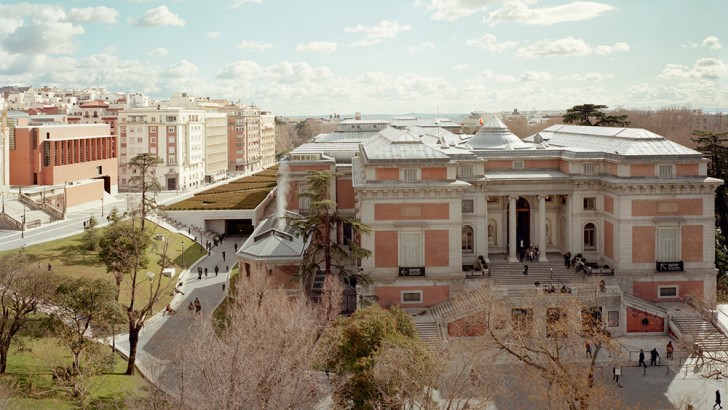[Interview] Explore the V&A’s Rich and Expansive Archive Through Samsung Art Store
on June 30, 2023
In the age of digital art, Samsung Art Store and the V&A (Victoria and Albert Museum, London) are working to create a harmonious connection between technology and creativity. Together, they have harnessed the power of the Art Store to make the V&A’s extraordinary collections available to art enthusiasts all around the world.
Samsung Newsroom sat down with Marta Di Gioia, a member of the Brand Licensing department’s research team, to discuss insights into the visionary partnership.

▲ The V&A’s Ceramic Staircase

▲ The V&A’s Madejski Garden

▲ The V&A’s main entrance on Cromwell Road. Photo by James Medcraft
Expanding and Spotlighting the Museum’s Collections
Can you tell us about your role at the V&A?
As a member of the Brand Licensing department’s research team, it is my responsibility to shine a light on the museum’s holdings. I cater to the specific research requirements of licensees while maintaining the distinctive aesthetic of the V&A brand, capturing the essence of the institution’s unique narrative and the creativity displayed across its collections.
Collaborating To Enhance Access to Art and Inspire Creativity
How has the partnership between the V&A and the Art Store evolved from its inception?
Since 2018, this collaboration has broadly expanded access to art, enthralling art lovers and revolutionizing the way customers view the V&A’s collections. Together, the V&A and Samsung have unveiled more content and artworks — spanning centuries, continents and artistic movements so that customers can enjoy them from the comfort of their own homes.
How do you choose appropriate pieces from the V&A’s expansive collection for The Frame?
The V&A Brand Licensing team explores the museum’s magnificent archives for striking images and diverse selections of assets that resonate with the Art Store audience. Some pieces of art and design are simply perennial favorites. Others are chosen so that viewers can explore the background of each piece, unearthing narratives and storylines about the artist’s intentions.

▲ The Great Wave off Kanagawa, Katsushika Hokusai (1760–1849), Japan, about 1831

▲ Design for a printed cotton, William Kilburn (1745–1818), England, 1788–92
Could you tell us about the “V&A: Ocean Treasures” curation for The Frame?
“V&A: Ocean Treasures,” launching in July to celebrate summer, is an eclectic selection of art featuring the themes of marine flora and fauna, romantic seascapes and glamorous holidays. The images in this collection span photography, illustrations, watercolors and oil paintings, embodying the artistic style and techniques of the different centuries in which they were created.

▲ The Brig on the Water, Gustave Le Gray (1820–84), France, 1850s

▲ Discomedusae – Jellyfish, Ernst Haeckel (1834-1919), Art Forms in Nature, Germany, 1899-1904

▲ L’Immensité, Gustave Courbet (1819–77), France, 1869
How does the V&A’s licensing program build upon the museum’s mission to make art accessible to all and inspire creativity?
The V&A’s award-winning licensing program began over 25 years ago and currently has more than 95 licensees worldwide. As we illuminate our collections by supplying tailor-made research, supporting design processes and shining a light on the fascinating story behind each artwork, we strive to make the museum’s celebrated holdings more accessible to a new and wider audience.

▲ Design for a printed cotton, William Kilburn (1745–1818), England, 1788–92
Out of the more than 20 works of art selected for the Art Store, which three pieces look the most impressive on The Frame?
“Tiffany 3” by Nigel Quiney, “London by Gaslight” by Paul Martin and the Victorian collage of seaweed specimens are some of the most impressive pieces from the V&A’s Art Store portfolio as they perfectly capture the breadth of the museum’s collections.

▲ Tiffany 3, Nigel Quiney, London, 1968
“Tiffany 3” is a 1968 pattern for wrapping paper by English designer Nigel Quiney (b.1939). Quiney’s psychedelic patterns epitomise vibrant Pop Art from the era of Swinging London through his use of psychedelia, as well as Art Nouveau and Art Deco influences.

▲ London by Gaslight, Paul Martin (1864–1944), London, 1896
“London by Gaslight” is a monotone photograph by Paul Martin displaying Piccadilly Circus at night in 1896. This image is part of the extraordinary Royal Photographic Society Collection — a significant component of the V&A’s world-class photography collection partly showcased in the museum’s newly expanded Photography Center.

▲ Seaweed specimens, Britain, 1878
“Seaweed Specimens,” a collage of pages from a Victorian scrapbook, is featured in July’s “V&A: Ocean Treasures” collection. The scrapbook is particularly interesting because it includes 30 sheets of well-preserved pressed seaweeds with each specimen named, reflecting the interest in amateur botany that developed in the 19th century and giving us a view of leisure pursuits and domestic pastimes of the time.
Preserving Art of the Past While Paving the Way for Art of the Future
What impact do you think recent technological advancements have had on the art world?
Recent technological advancements have broken down geographical barriers, allowing museums and galleries to digitally showcase their collections to a worldwide audience, while virtual reality and augmented reality have revolutionized traditional exhibition spaces. This blurring of the physical and digital realms has enriched the viewer’s engagement, making art more accessible and engaging for all.

▲ Typhoon, Nigel Quiney, London, 1969
What part does digital art and design play in the V&A’s permanent collections?
With a forward-thinking vision, museums are spearheading innovative initiatives to captivate and immerse visitors in the realm of digital artistry like never before. The V&A recognizes the profound impact of digital art and design on contemporary culture and seeks to showcase and celebrate their significance within its diverse collection.
The transformative power of technology can shape contemporary artistic expression, foster dialogue and inspire visitors to explore the intersections of art, design and digital innovation.
Visit the Samsung Art Store in The Frame to explore more of the V&A’s collection.
Images © Victoria and Albert Museum, London


